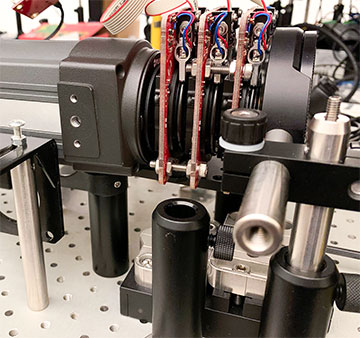Researchers used a stack of spinning metasurface devices to capture spectral and polarization details of thermal radiation as well as the intensity information that is acquired with traditional thermal imaging. [Image: Xueji Wang, Purdue University]
Researchers at Purdue University, USA, have created a compact, robust thermal imager that employs a stack of spinning metasurfaces for spectro-polarimetric decomposition (Optica, doi: 10.1364/OPTICA.506813). Since it captures more detailed information than previous methods, the approach has potential applications for security, autonomous navigation, remote sensing and predictive maintenance for industrial settings.
Smaller imager
In 2023, Zubin Jacob and his colleagues developed heat-assisted detection and ranging (HADAR), the thermal equivalent of methods like light detection and ranging (lidar and radar). HADAR enables detailed texture in thermal imaging, allowing for machine perception even in complete darkness. Instead of emitting and receiving signals for detection, HADAR leverages the fully passive heat signals that originate from infrared thermal radiation.
The technology requires spectral resolution within the long-wave infrared (LWIR) region. However, conventional thermal imagers are generally bulky and delicate, mainly due to their dependence on large filter wheels or interferometers. They also suffer from significant information loss, resulting in blurry thermal images.
“Our research focuses on creating a method to capture both spectral and polarization information in a more compact and efficient manner,” said study author Jacob. “This advancement is a significant step toward the broader adoption of HADAR technology, potentially making it as common as radar, LIDAR and sonar.”
The end result is the Spinning MetaCam, a system based on a stack of spinning metasurfaces that is compact, robust and versatile. The portable device is roughly 10 cm × 10 cm × 10 cm, making it adaptable to a broader spectrum of applications than traditional imagers, such as autonomous navigation.
The stack of spinning metasurfaces breaks down thermal light into its spectral and polarimetric components. The researchers combined the metasurface stack with a traditional long-wave infrared camera and computational imaging algorithms to create a compact and robust spectral thermal imaging system. [Image: Xueji Wang, Purdue University]
Greater accuracy
The Spinning MetaCam comprises a broadband linear polarizer, three anisotropic and dispersive metasurfaces and a standard LWIR imaging sensor. The device axially spins the polarizer and metasurfaces to different angles, obtaining tunable transmission spectra that sample the incoming thermal radiation signal in its spectral and polarimetric channels. Computational algorithms then analyze the data, providing detailed spectral and polarization information for every pixel in the resulting thermal images.
Jacob and his colleagues tested the platform using a custom “PURDUE” imaging target composed of various materials and microstructures, each with unique spectro-polarimetric properties. The results demonstrated a threefold increase in material classification accuracy compared with traditional thermal imaging methods.
“Our next step will focus on enhancing spectral resolution, transmission efficiency and the speed of image capture and processing,” said study author Xueji Wang. “These advancements are key for moving this technology from the lab to commercial use.”



